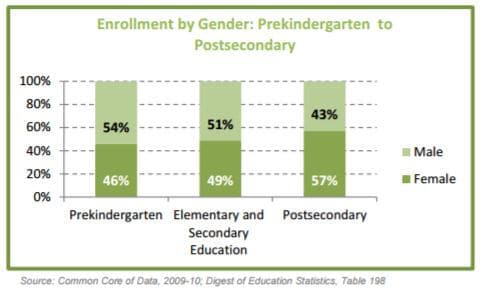Single-Gender Education 101: Pros and Cons of Single-Sex Education

Most schools and universities have classrooms filled with boys and girls in equal numbers, right?
Wrong.
It would seem that this should be the case, but the U.S. National Center for Education Sciences provides some starkly different data.

Public schools are filled with a larger percentage of male students than female students, especially in pre-k. In Elementary and secondary education, males outnumber females 51% to 49%.
Once students move on to college, females account for most the student body. In 2016 there were an estimated 11.7 million female students and only 8.8 million males. Here is a table with student projections all the way to 2025.
Does this imbalance have any noticeable affect on student learning? Would it be useful to introduce more gender separation in schools? Or maybe some of this imbalance is caused by competing for education alternatives and existing single-gender schools?
Let’s take a moment and explore the issue of single-sex education and see if there’s anything worth arguing about.
Page Navigation
Single-Gender Education: A history of conflict
Single-sex education started becoming increasingly popular in the late 1990's although the first single-gender schools were established in the 18th century. The rise in popularity spawned after the United States department of justice filed a lawsuit against Virginia military Institute in 1990.
The lawsuit argued that VMI was discriminating against women while using public funding. Although VMI won its court case, it was appealed several times until the Supreme Court found it was unconstitutional for a school supported by public funds to Bar women from admissions.
As VMI considered becoming a private institution in order to avoid this Supreme Court ruling, The assistant secretary of defense threatened that the department of defense would withdraw all of their funding if the school became private. This caused Congress to prohibit the department of defense from removing or reducing their ROTC funding. By this date, VMI already voted in favor of admitting women and so in 1997 female cadets were enrolled.
VMI had brought single-sex classrooms to the front and center of United States education politics. Later in 2006, No Child Left Behind created a loophole that allowed single-sex classrooms to exist if, and only if, they were voluntary.
Reasons to advocate for a single gender classroom
Back in the 1990s, it was argued that a split gender classroom would give women more advantages to excel academically. Popular arguments claimed that male and female learning styles were very different, and thus classrooms would be more individualized and effective if the genders were separated.
However, at present, there are some potentially more compelling arguments. One hope is that single-sex education will enable women to perform better in STEM, where females are statistically lower. Another hope is that such classrooms would reduce dropout rates among urban African-American and Latino males.
There are many good intents behind each position, making it a very sensitive and difficult issue. Nevertheless, the sensitivity of the issue didn't stop journalists like Margaret Talbot from being outspoken. Talbot wrote in 2012 that there wasn't very much evidence back in the 1990's and it hasn't gotten any better since then.
Study Data: How the general public views single-sex education
Survey data from a Harvard University sponsored study gives us a glimpse into the mind of the public opinion.
Over 33% of the (American) survey participants think parents should have the option of sending their children to a single-sex school.
25% of respondents opposed parents having the option to send their child to a single-sex school.
Although the larger percentage of respondents wanted the choice to be available, only 14% of them said they definitely would consider a single-sex school for their own children.
28% of respondents said they probably would consider sending their own children to a single-sex school.
What are the disadvantages of a single gender classroom?
What it really boils down to is an extreme lack of concrete evidence. Many of the claims that are used to support single-gender classrooms are not backed by any real evidence/studies.
One big con is the fact that society does not operate with separation between genders. If genders interact together in society, the workforce, and every other aspect of life, why should students’ education be any different?
One of the strongest arguments against this segregation is that public funds cannot be used to support an approach that has not demonstrated any substantial empirical evidence.
Are girls and boys' brains fundamentally different?
Plenty of children defy gender norms.
From a psychological standpoint, the most interesting recent development is the study of brain developmental and learning differences between boys and girls. There are no conclusive results. However, most evidence suggests that there is no innate predisposition for girls to be disadvantaged in the STEM subjects. Researchers showed that girls do better in math in countries with the greatest degree of gender equity.
Lise Eliot, in Pink Brain, Blue Brain, argued that the ideas of boys/girls having “innate” and “hardwired” predispositions are hogwash.
In the past decade, we’ve heard a lot about the innate differences between males and females. So we’ve come to accept that boys can’t focus in a classroom and girls are obsessed with relationships: “That’s just the way they’re built.” Lise Eliot turns that thinking on its head.
Boys are not, in fact, “better at math” but at certain kinds of spatial reasoning. Girls are not naturally more empathetic than boys; just allowed to express their feelings more.
What I found, after an exhaustive search, was surprisingly little solid evidence of sex differences in children’s brains.
— Lise Eliot [source]
Ultimately, it remains to be shown if there are real advantages to segregating classrooms by gender.
Therefore, the validity or weight of each “pro” and “con” is highly subjective and completely lacking in scientific substance. Most evidence seems to debunk the benefits of gender-separation. For instance, when boys performed better in gender-segregated schools, it was very likely because they were given additional mobility and freedom to move about the classroom. (That almost sounds humane, doesn't it?)
Below you will find a table of the most commonly stated reasons (arguments) for, and against, single-sex education.
Commonly Cited Pros and Cons of Single-Sex Education
| Pros of Split-Sex Classrooms | Cons of Split-Sex Classrooms |
|---|---|
| Opposite genders distract one another. | There is no scientific evidence that this is true. Additionally, there is no separation of genders in the real world, such a scenario is very unnatural. |
| Single-sex schools help remove negative gender-based stereotypes. (i.e. only girls can like delicate art and only men can enjoy wrestling) | Segregation can lead to the development of new stereotypes. Much worse, it could lead to difficulties acclimating to the opposite gender. |
| Slower developing boys hold back faster developing girls. | No Child Left Behind and CCSS are already holding children back, so gender is not a primary factor. Furthermore, there might be benefits of allowing mature girls to influence less mature boys. |
| Teachers can use gender-specific techniques in the classroom that will improve the overall performance and quality. | Once again, strong scientific evidence is lacking. Plus, not every teacher knows how to employ such advanced techniques. |
| Teachers often respond differently to males vs females | Promotes gender stereotyping |
| Proximity leads to increased sexual activity that leads to pregnancy/STDs. | Children/students need to learn to control their lust/emotions/desires because such an artificial separation does not exist in the real world. |
| Gives each gender equal opportunities for dominant leadership roles that may be difficult to achieve in mixed-gender classrooms. | This may exacerbate sexist attitudes and gender stereotypes. |
| Improves peer interaction | Undermines gender equality. |
This list could continue for quite some time, and it is surprisingly difficult to make a strong argument because there are sociological, philosophical, moral, political, economical, and scientific reasonings backing different explanations. And, of course, plenty of stereotypes.
In the end... Lego had it right all along.

Photo Credit: Imgur
Additional reading and references
For anyone looking to read more about the single-sex debate in education, here are sources I read and found interesting.
- The never-ending controversy over all-girls education
- Legal issues surrounding single-sex schools in the U.S
- How Boys and Girls Learn Differently single gender education, single sex classrooms, education, high schools
- Theoretical arguments for and against single-sex schools: A critical analysis of the explanations
- Separated by Sex: Title IX and Single-Sex Education
- Leonard Sax MD Ph.D., Why Gender Matters
- Boys & Girls Together? Courts Deal with a Push to End Co-Ed Classes
- The Growth of Single-Sex Schools: Federal Policy Meets Local Needs and Interests








you seem really smart and i love it! 🙂 keep it up!